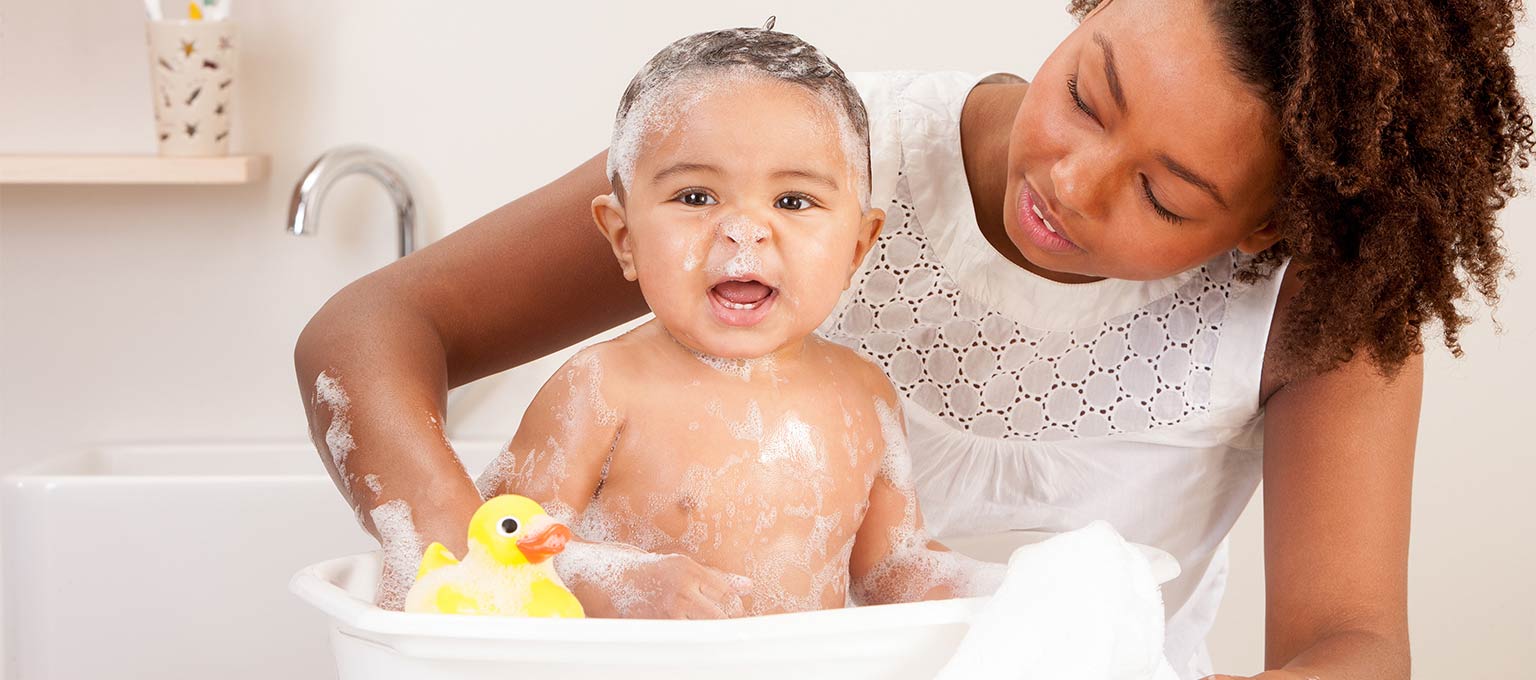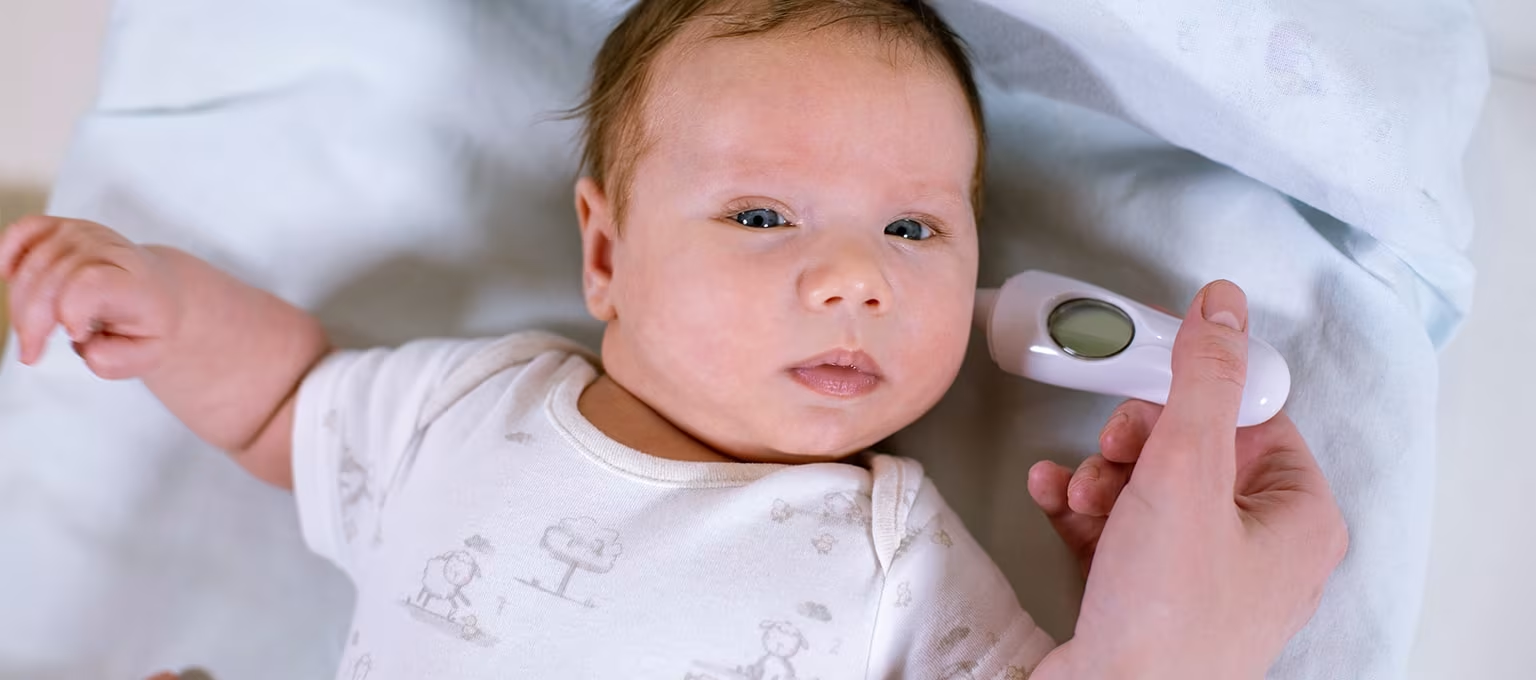
The 10 Best Baby Thermometers
Key Takeaways
As your child grows, there will likely be times when you suspect your little one has a fever or is sick. You'll want to have a baby thermometer in the house to check your baby’s temperature and find out if it is higher than usual. Although a thermometer can never replace a diagnosis by your healthcare provider, having a reading of your child’s temperature can give you some insights that you can take to your provider should you see signs of a fever or other symptoms of sickness. We surveyed more than 7,000 Pampers Parents to find out which baby thermometers they think are the best and then reviewed the top 10 products. Plus, we’ve described the different types of baby thermometers on the market; listed what to consider when buying a baby thermometer; and given you a step-by-step guide on how to use your baby thermometer once you’ve got one at home.
Types of Baby Thermometers
Experts recommend using one of these types of baby thermometers:
With all of these baby thermometers, the temperature is typically shown on a small digital screen.
Some Thermometer Dos and Don’ts
There are a lot of good thermometers. Pick one that is easy to use on a squirmy baby or toddler.
Pampers Parent
Things to Consider When Buying a Baby Thermometer
I considered ease of use, ability to use on a difficult baby, ability to use without disturbing a sleeping child, and, lastly, price when shopping for a thermometer.
Pampers Parent
Here are some features to look at when choosing the best baby thermometer for you and your little one:
How to Use a Baby Thermometer
Whenever you suspect your baby might have a fever, take their temperature. Because each thermometer is a little different, you should always follow the manufacturer’s instructions carefully. However, here are some basic steps to follow:
1. Clean the thermometer following the instructions that came with the product. Cleaning it with soapy water or rubbing alcohol, and then rinsing it with cool water may be all that’s needed.
2. Place the thermometer as directed in the instructions. This could be on the forehead, under the underarm, or in your baby’s bottom or ear. If you use the thermometer rectally, you should put a small amount of petroleum jelly on the tip to lubricate it. If you use an ear thermometer, it may require a probe cover. Never leave your little one unattended with the thermometer.
3. Leave the thermometer in place as long as suggested in the product guidelines. This is usually a few seconds up to about a minute. Some models signal when the thermometer has taken a reading; for others you’ll have to watch the clock.
4. Check the reading. Typically, a reading of 100.4 degrees Fahrenheit or higher indicates a fever.
5. Contact your child’s healthcare provider right away if you’re ever concerned about your little one’s temperature or symptoms, or in these situations:
6. Disinfect the thermometer according to the manufacturer’s instructions and place it back in its case or cover. Store safely out of reach of children.
The 10 Best Thermometers for Your Baby or Toddler
Here are the top-rated baby thermometers as chosen by thousands of Pampers Parents:
1. Safety 1st 3-in-1 Nursery Thermometer
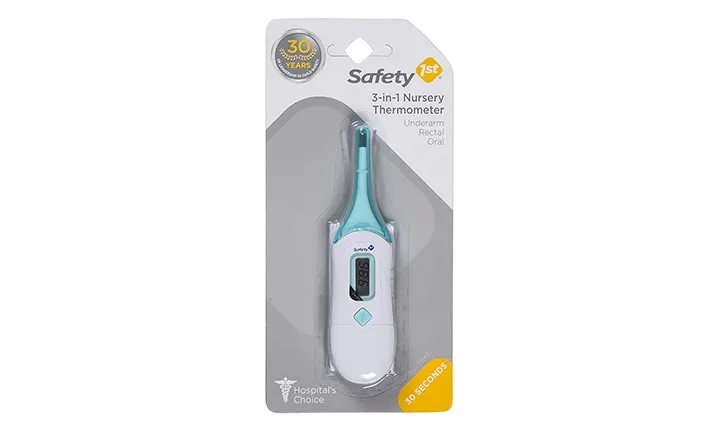
Why pick this one? The Safety 3-in-1 Nursery Thermometer gives you three options for taking your baby’s temperature: orally, rectally, or under the arm. After 30 seconds, the thermometer beeps to let you know the reading is complete. Pampers Parents chose this thermometer as no. 1 because it’s budget-friendly, offers three ways to take a temperature reading, and it’s simple to use. A storage case is included with the thermometer, and a long-lasting battery. The thermometer can also recall the last reading, features auto shut-off, and can switch between Celsius and Fahrenheit.
This thermometer is more accurate and reliable on temperatures than the forehead thermometer we had initially purchased. It’s small and fits in our travel size bag of necessities for our baby daughter.
Pampers Parent
Highlights: The tip is flexible for comfort and includes a rectal guard to use when you’re reading your baby’s temperature rectally.
Price*: about $4.99 on Amazon.com
Pampers Parents pros and cons:
2. FridaBaby Quick-Read Digital Rectal Thermometer

Why pick this one? There’s no need to worry when taking your baby’s rectal temperature with the FridaBaby Quick-Read Digital Rectal Thermometer. That’s because there’s a parent-proof stopper so you don’t hurt your baby’s bottom, and the tip is flexible. There’s a large display so it’s easy to read the temperature, and backlighting makes it even easier to read, especially in low light. The thermometer saves up to 10 previous readings and includes a carrying case.
It’s short so you don’t have to worry about pushing it in too deep (helps especially when your little one is a wiggler) and the flexibility and rubber material ensure that there is no chance of the tip breaking.
Pampers Parent
Highlights: The thermometer is BPA- and latex-free, as well as water-resistant for easy cleaning.
Price*: about $13.59 on Amazon.com
Pampers Parents pros and cons:
3. Braun Thermoscan 7 IRT6520 Thermometer

Why pick this one? This thermometer is one of the more expensive ones on this list, but many Pampers Parents felt it was worth it. This thermometer offers lots of bells and whistles, including
This is such a great thermometer. Not only is it quick and easy to use, but it also helps little ones learn it’s okay to have their ears touched. Since using this with my second child, he now allows his doctor to look inside his ears far easier than my first child ever did.
Pampers Parent
Highlights: This product comes with 40 lens filters that cover the probe that enters the ear. If you run out of these probe covers, you’ll have to buy more.
Price*: about $66.82 on Amazon.com
Pampers Parents pros and cons:
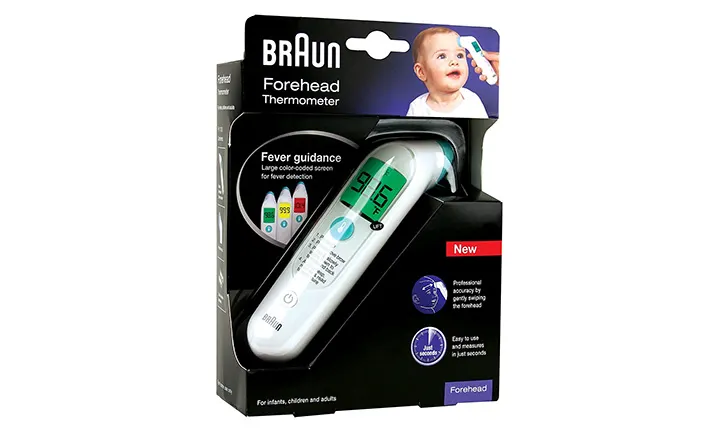
Why pick this one? With the Braun Forehead Thermometer, you simply swipe the temperature reader along your baby’s forehead to the temples twice to get a reading within seconds. The display shows the temperature reading in big letters, and the screen itself changes color to help you more easily identify the reading:
This thermometer is easy to use with a simple on/off switch and a green button you have to press while taking a reading, but some Pampers Parents found that setting certain options (like switching between Fahrenheit and Celsius) can be a little tricky. Highlights: This thermometer allows you to take your child’s temperature without waking them or removing any clothing.
Price*: about $56.00 on Amazon.com
Pampers Parents pros and cons:
5. Vicks ComfortFlex Digital Thermometer

Why pick this one? This digital baby thermometer is great because it allows you to take a reading rectally, orally, or from the underarm. The manufacturer claims it can give a temperature reading in as few as 8 seconds, but an armpit reading could take around 22 seconds. The display of this thermometer changes color based on the reading:
Just like most of the other thermometers on this list, it can give a reading in both Fahrenheit and Celsius, and it’s also suitable for use on the older children and adults in your family.
I can use this under my baby’s armpit and get as good of a reading as the hospital thermometer. I have tried the forehead thermometers and spent a lot of money on them and they read two to three degrees lower than others.
Pampers Parent
Highlights: This thermometer has a flexible tip for extra comfort for your little one. It’s BPA free and water resistant.
Price*: about $9.98 on Amazon.com
Pampers Parents pros and cons:
6. Goodbaby Baby Thermometer with Fever Alarm and Memory Function
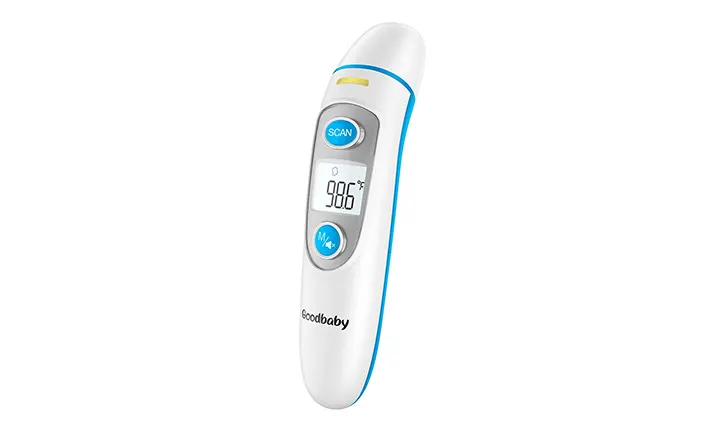
Why pick this one? The Goodbaby Thermometer is more than just a regular thermometer: it not only read temperatures from the forehead or ear, but can also measure the temperature of a room or measure food temperature. It can also easily switch between Celsius and Fahrenheit. Even though it’s marketed as a baby thermometer, the Goodbaby Thermometer is recommended for all ages, from infants to seniors. With the backlit LCD screen, it’s easy to read the temperature, even in the dark at night. It’s also equipped with a fever warning indicator:
If you need to take your baby’s temperature when they’re sleeping, you can mute the thermometer, so the beeps don’t wake them.
This thermometer is easy to use. I like that it doesn't wake up my baby if I check her temperature while she's sleeping.
Pampers Parent
Highlights: You don’t have to worry about the batteries running out so fast since the thermometer features an auto shut-off feature.
Price*: about $17.99 on Amazon.com
Pampers Parents pros and cons:
7. iHealth No-Touch Forehead Thermometer
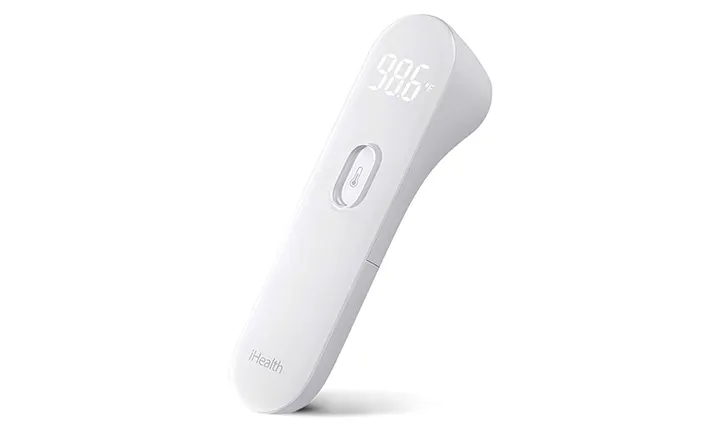
Why pick this one? Another infrared thermometer, the iHealth No-Touch Forehead Thermometer reads temperatures when held within 1.18 inches of the forehead. Just point at the center of your little one’s forehead. The thermometer is recommended for children of all ages and adults too, so it’ll be perfect for the entire family. If you didn’t like the beep alerts of the previous infrared thermometers on this list, you may like the vibrating indicator of the iHealth Thermometer, which vibrates after it’s finished taking the reading. Unlike some of the other thermometers in this list, the iHealth Thermometer doesn’t offer color indications for normal temperature, mild, or high fever. It also doesn’t save previous readings. You may want to think about whether these extra features are deal breakers or not.
I love the vibration notification feature! Instead of a beep when the temperature is captured, the thermometer vibrates. This is so helpful to us as dog owners whose pet goes bonkers when things chime and beep. No middle-of-the-night barking and wake-ups!
Pampers Parent
Highlights: A clear and bright oversized LED screen ensures that you can read the temperature even in complete darkness.
Price*: about $19.99 on Amazon.com
Pampers Parents pros and cons:
8. EasyEast Touchless Infrared Thermometer
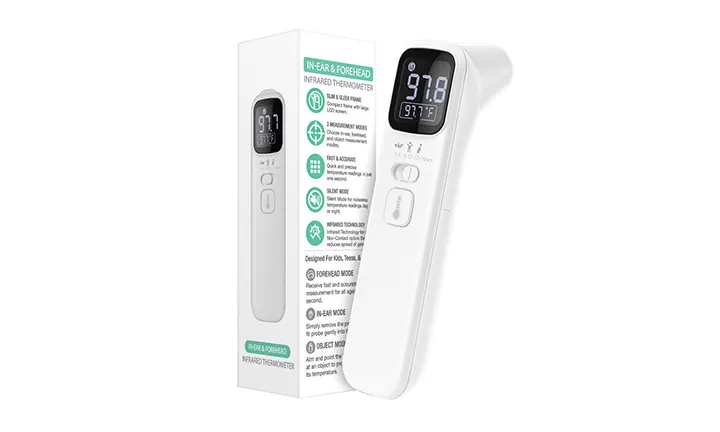
Why pick this one? The EasyEast Touchless Infrared Thermometer goes beyond a regular infrared thermometer—it also takes readings in-ear and can take the temperature of objects. For in-ear readings, just switch out the tip of the thermometer. It’s also easy to toggle between Celsius or Fahrenheit. With the press of a button, you can have your child’s temperature read in 10 seconds. The LED screen is backlit, making it easy to read, and shows temperature readings in green for normal, orange for mild fever, and red for high fever. The thermometer shuts off after 10 seconds of non-use to save on its battery life. You will need to purchase two AAA batteries, which aren’t included in the box. Highlights: Use silent mode whenever you need to take your little one’s temperature without waking them.
Price*: about $10.49 on Amazon.com
Pampers Parents pros and cons:
9. Femometer Touchless Thermometer for Adults and Kids
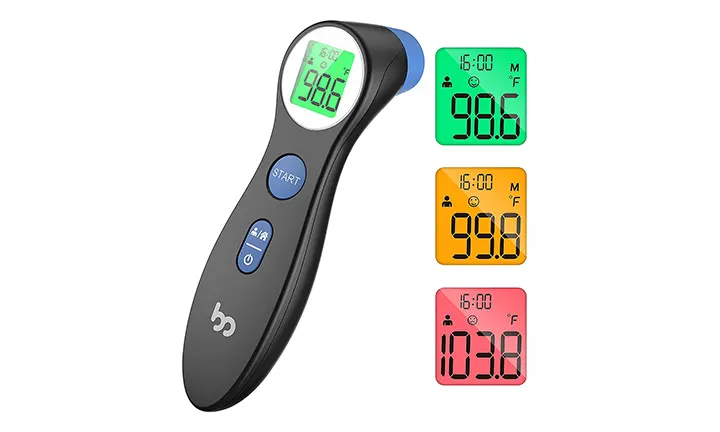
Why pick this one? The femometer Touchless Thermometer measures temperatures of people, objects, and rooms—hence the three-in-one feature. It can be used for both adults and children. The large backlit LCD display is easy to read and features color-coded indicators: green for normal temperature, yellow for mild fever, and red for high fever. The red reading will also include a warning sound to make sure that you’re aware its reading is high. The thermometer can store 10 previous readings and can easily switch between Celsius and Fahrenheit.
I can get my baby’s temperature without having to stick the thermometer in his mouth, underarm, or you know where! When a baby is sick, they are already super uncomfortable. This is the best thermometer for everyone.
Pampers Parent
Highlights: With your purchase you also get 24-hour customer service in case you need help with the thermometer.
Price*: about $19.99 on Amazon.com
Pampers Parents pros and cons:
10. OCCObaby Clinical Digital Baby Thermometer
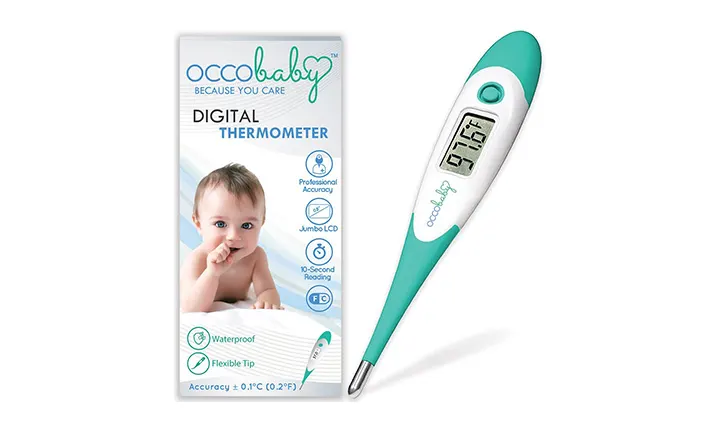
Why pick this one? If you’re looking for a standard digital thermometer that will get the job done without too many added features, then this OCCObaby model is definitely one to consider. The thermometer can be used rectally, which experts consider to be the most accurate way to gauge your baby’s temperature, or under the arm, or orally once your child is 4 or 5 years old. This thermometer has a flexible tip; is waterproof; offers a quick 10-second reading; has a large digital display; offers both Fahrenheit and Celsius options; and has a fever alarm that beeps if it reads a high temperature. This thermometer automatically powers off, which might help save on battery life. One LR44 battery is required.
I love this thermometer because it’s just simple and I don’t really like the new forehead thermometers. This one is easy to stick under your baby’s arms or in his rectum. The tip of it is very flexible and soft so you can wiggle it or tilt it without harming the baby.
Pampers Parents
Highlights: The small size means that it’s great for babies and young children. It also comes with a storage case to keep it protected and clean.
Price*: about $14.99 on Amazon.com
Pampers Parents pros and cons:
The Bottom Line
When your little one has a fever, you'll appreciate having a thermometer in your medicine cabinet or first aid kit that can provide information promptly and accurately. Be sure to reach out to your baby's healthcare provider with any questions or concerns, especially if your baby seems unwell or has a temperature. The provider can diagnose any medical conditions and offer expert guidance on how to care for your little one.
- Book: Caring for your baby and young child, birth to age 5, Sixth Edition Paperback – November 2, 2014 by American Academy of Pediatrics (Author)
- Consumer Reports: Thermometer Buying Guide
Read more about Best Baby Products
Related Articles
Join a World of Support
through Pregnancy and Parenthood.
TRACK WITH TOOLS
LEARN WITH EXPERTS
GET REWARDED



